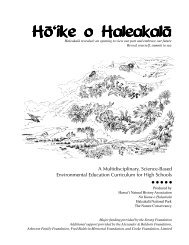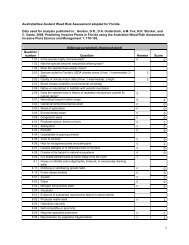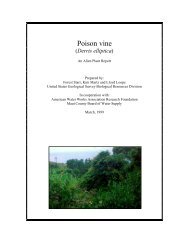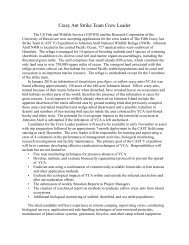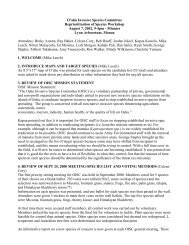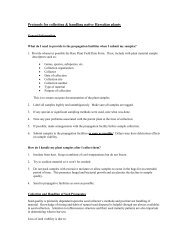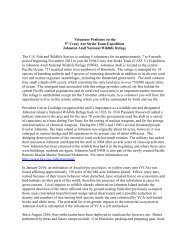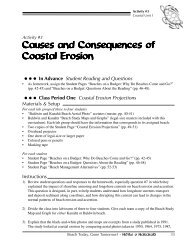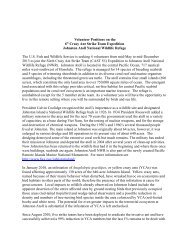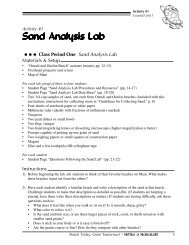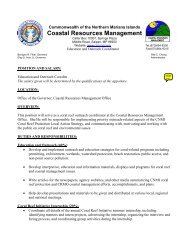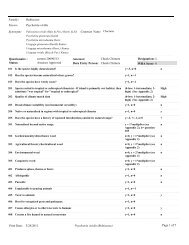MAUI INVASIVE SPECIES COMMITTEE MEETING FRIDAY ...
MAUI INVASIVE SPECIES COMMITTEE MEETING FRIDAY ...
MAUI INVASIVE SPECIES COMMITTEE MEETING FRIDAY ...
You also want an ePaper? Increase the reach of your titles
YUMPU automatically turns print PDFs into web optimized ePapers that Google loves.
<strong>MAUI</strong> <strong>INVASIVE</strong> <strong>SPECIES</strong> <strong>COMMITTEE</strong><br />
<strong>MEETING</strong><br />
<strong>FRIDAY</strong>, NOVEMBER 9, 2001<br />
9 AM TO NOON<br />
ATTENDANCE: Ron Nagata, Bob Hobdy, Randy Bartlett, Fern Duvall, Renate Gassmann-Duvall,<br />
Erik Barnard, Mike Ade, Steve Anderson, Kim Martz, Forest Starr, Nathan Varns, Jack Peterson,<br />
Christy Martin, Pat Bily, Eric Nishibayashi, Elizabeth Anderson, Jeremy Gooding, Mike Avery, Philip<br />
Thomas, Glenn Shishido, Mike Richardson<br />
- The meeting was called to order by Randy Bartlett (MPC/Chair) at 9:03am.<br />
- Randy introduced Mike Avery who is here from USDA/APHIS in Florida to advise MISC on<br />
parrots.<br />
NEW BUSINESS<br />
PERSONNEL STATUS<br />
- Erik Barnard started work with us in a temporary position about two weeks ago. Erik was recruited<br />
from The Nature Conservancy and is working alongside Mike Ade. Erik’s start was very timely<br />
because Mike injured himself with a machete (not on the job) and had to have surgery. Mike won’t<br />
be able to go out in the field for awhile. Erik has been able to fill in. Both Erik and Mike have<br />
some great ideas. We are now changing some of our data systems and revising procedures and<br />
their input has been very valuable.<br />
- Jayson Barangan will be leaving MISC on Nov. 16 to go back to school. Jayson is the last of the<br />
original MISC crew and will be missed. We will be recruiting Jayson’s replacement soon. Please<br />
pass the word if you know any good people who might be interested.<br />
- The West Maui Mountains Watershed Partnership is also recruiting field workers and a field<br />
supervisor. The announcements are on our bulletin board if anyone knows of potential candidates.<br />
- MISC is also planning to recruit a Field Operations Manager in the next couple of months.<br />
<strong>MEETING</strong> MINUTES APPROVAL<br />
- Minutes from the September 28 th meeting were approved. They will be posted on the web-site. If<br />
anyone has corrections, please let us know. The minutes were distributed earlier this week and no<br />
changes have been received.<br />
BUDGET/FUNDING STATUS REPORTS<br />
Coordinator’s Budget Report (J. Peterson, MISC Coordinator)<br />
- Nothing too much has changed since the last meeting. We are still working on securing funds that<br />
have been awarded.<br />
- We just submitted our 2002 NFWF funding proposal for $100,000 at a 1:1 match. It was a team<br />
effort to pull it together again this year. We think we have a good chance at another year’s funding<br />
from NFWF. We owe a big thank-you to Tri-Isle RC&D for letting us go through them again this<br />
year for the proposal. Thanks also to all those who wrote letters of support. NFWF funding is for<br />
plants only.
- We hope to have the 2002 Action Plan finished by Tuesday. There is a Forest Service pre-proposal<br />
due on Tuesday and we would like to have the Action Plan ready to support it. The results section<br />
is ready, but we still have some maps to develop. We need copies for the legislature made as soon<br />
as it is ready. Randy will work with Christy to figure out how many copies to prepare. The parrot<br />
section is finished. Earl is reviewing the frog section before it comes to us.<br />
Hana Crew/County Funding Update (Nathan Varns, Tri-Isle RC&D)<br />
- We are still working on the logistics of transferring the Hana crew to RCUH payroll. We are<br />
running a little behind schedule on the transfer. PCSU was having computer problems and that<br />
slowed things down. We are projecting the transfer will happen towards the end of the year.<br />
- We tentatively have approval for more hours for our bookkeeper. This will give us greater<br />
capacity. She will basically be serving as the financial officer for Tri-Isle.<br />
- We are currently using the Water Department grant from 2000 to pay the crew.<br />
- We are one person short on the crew right now. Bruce Lind left to work for the Highway<br />
Department. We probably won’t hire a replacement until the transfer to RCUH is complete.<br />
State Funding Update/DOFAW Budget (Bob Hobdy/Glenn Shishido, DOFAW)<br />
- We are still trying to make ends meet. When Fred left our focus in Honolulu left and consequently<br />
they kind of forgot Maui when putting together budgets for this year. Mike Buck has Karl Dalla<br />
Rosa working on this. Personnel costs are covered, but they are still working on operational<br />
expenses (helicopter time, vehicles, maintenance, herbicide, supplies, etc.). We asked for $70,000<br />
and if we get that we will put in another section of road in the Kaiwaipapa area. If we don’t get the<br />
funding we will have to relay on helicopters and what help we can get from MISC in the upper<br />
area. We need $10-12,000 for the road portion. About 1.5 miles of new road are proposed. There<br />
will need to be an Environmental Assessment.<br />
- Jack added that MISC will help GPS the area. We have been talking to Glenn about this. If<br />
necessary, MISC could reshuffle county funds to help with the road. The road was included in the<br />
original county proposal and then the funds were shuffled to bio-control when we thought the road<br />
was covered.<br />
Legislature’s $1.5M Emergency Environmental Workforce Bill<br />
- The statewide $1.5M Emergency Environmental Workforce Bill was officially approved during the<br />
special session. It will go through RCUH/PCSU. The different ISCs will be the primary<br />
beneficiaries. David Duffy has requested draft working plans from everyone that might be able to<br />
take a crew. The people hired will work for three months.<br />
- Jack presented the proposal he submitted for MISC. In this proposal MISC stressed that the<br />
optimum scenario would be fewer people for the longest possible hiring period with the highest<br />
supervisory ratio possible. We’ve indicated that we could take a minimum of 12 workers up to a<br />
maximum of 36 for miconia plus an additional 5-10 for other MISC projects without a foreman.<br />
We would prefer a supervisory ratio of one foreman to five workers. We would really like to be<br />
able to stretch a few of the positions out for more than three months. There was an editorial on the<br />
program in the Wednesday Maui News. This is coming really fast. We need to make provisions<br />
for equipment, vehicles, safety, etc.
- David Duffy has said he will try to expedite the recruitment process. We need selection capacity<br />
and the ability to screen for physical requirements. The numbers of workers will be above our<br />
present supervisory capacity. We need to be able to hire some people with supervisory capacity.<br />
Duffy’s office was originally looking at 8-10 crew members per supervisor. We prefer a lower<br />
ratio. He is also looking at the possibility of stringing some positions together for six months<br />
instead of three.<br />
- The most appropriate mission we could use these people on would be miconia.<br />
- There will be a number of associated expenses such as transportation, PPE, equipment, etc. We<br />
need to be able to base these people out of Hana as much as possible. We may need to make<br />
provisions for lodging or hiring folks from the Hana area.<br />
- Randy suggested we may be able to use these workers for parrot monitoring and surveys also. Fern<br />
asked about survey work, especially on Molokai. With a lot of people you can survey even with<br />
only a short period of time available.<br />
- Renate suggested that we should consider using the EEW workers for bird surveys. We could buy<br />
them each a pair of binoculars. They don’t have to be in totally wild terrain to do bird surveys.<br />
These people will likely go back into the hotels when the economy turns around and this is a good<br />
education opportunity. Yvette is already putting out feeding stations and has indicated they could<br />
use help with monitoring the feeding the stations. Renate would like a crew of roughly 10 workers<br />
from the EEWF to help with parrots.<br />
- Randy commented that the dengue link with the EEWF still needs to be worked out with the<br />
Department of Health. There have been three new cases of dengue in Hana so we aren’t done with<br />
this yet. The Department of Health is using volunteers to do a lot of the spraying right now and<br />
they could do the initial training for the EEWF.<br />
- Randy also suggested that if we used the EEWF to do surveys we could possibly have them use<br />
their own vehicles and then reimburse for mileage. This would help with the transportation issue.<br />
- Ron Nagata added that a three month hire doesn’t sound very effective. The current RCUH limit is<br />
four months for temporary employees so extending positions to six months could be a problem.<br />
- Steve A. added that the park EPMT crew is looking at being able to handle about 15 EEWF<br />
workers within the current supervisory capacity to work in concert with MISC on miconia. If we<br />
are looking at these crews working on projects where there is important data we need to be sure<br />
there is adequate training and supervision.<br />
- Pat asked if we should be concerned with the hazards associated with putting these folks out to<br />
work in the field in areas where there is dengue fever. Is RCUH able to send people out into a<br />
disease area? He also made the point that there would be a lot involved for bird work.<br />
- Bob countered that they are more likely to get dengue fever in town than up in the mountains.<br />
- Philip added that we should keep in mind Wainapanapa is still closed to public. This may be an<br />
option for accommodations.
- Jeremy stated that supervision is quite a concern. Our crew members, both MISC and EPMT, can<br />
provide some supervision. Our crew members can be upgraded for this time period and we can see<br />
if they can handle it.<br />
- Pat suggested that MECO buses might be able to get people to and from Hana if they are hired<br />
from other parts of the island.<br />
- Tina Lau from Molokai will be putting in a bid for some EEWF workers. OISC has said they can’t<br />
handle any right now.<br />
- Jack added that we need to be aware that the EEWF focus could have negative impact on our<br />
secondary target species for the next couple of months. Randy suggested that it doesn’t have to but<br />
it could. MISC’s overhead and supervision, etc. should be considered as an in-kind funding match.<br />
Federal Funding Update Haleakala National Park (Steve Anderson)<br />
- The request to use fee money for miconia was declined pending changes in legislation that would<br />
make it legal to use federal dollars on non-federal lands. The fall back position is to take some soft<br />
funding that the park has for fencing and divert that to miconia work and then use fee money for<br />
the fencing projects. If the switch from fencing to miconia is approved there will be more<br />
involvement from Jeremy’s crew. Ron added that there are other funding sources that the<br />
superintendent is holding in case this doesn’t work out. The fencing funding for this year is<br />
$325,000.<br />
- Additionally, we will be putting in a soft money proposal for miconia through the NPS Natural<br />
Resource Preservation Program (NRPP). There is a meeting next week at HAVO to prioritize<br />
funding proposals for the Pacific Islands cluster. The challenge with this pot of funding is that it<br />
requires a discrete accomplishment for each year and after three years there must be a discrete<br />
finished product. Part of the justification will be that we are building a buffer to protect Haleakala<br />
and we want the biggest buffer possible. The maximum we can get through this program is<br />
$300,000 per year for three years. We are not sure if we should ask for the maximum. We may<br />
make this a multi park project and include the Big Island. A multi-park project may rank higher<br />
and be easier to sell. Steve has an email out to Duane, Greg, and Kim for feedback on what they<br />
could do discretely in a three year period.<br />
- The new proposal would be much cleaner and a much better scenario than shuffling around this<br />
year’s fencing money. The details on the switch for this year are being worked out and this money<br />
could start trickling down from WASO soon. We need to make sure that this fencing project gets<br />
done despite the reallocation of funds. It is a critical fence project.<br />
- Forest added that last night Cathleen and Timmy gave a talk at the Friends of Haleakala meeting<br />
and they mentioned that they would also like to use some of the fee demo funding for axis deer<br />
work.<br />
- Ron reminded everyone that it is illegal to use fee money outside the park. This is the solicitor’s<br />
read on the law. They aren’t against changing the law, but the law needs to be changed before fee<br />
funding can be used outside park boundaries. This impacts other parks in addition to Haleakala.
- Jack asked if Don’s original estimate of $1 million per year in fee funding is still accurate? Ron<br />
answered that it will probably be a bit less because visitation is down and there is the overlap<br />
between the summit and Kipahulu to factor in. It is likely to be closer to $700,000 in reality.<br />
- Jack reminded the group that our estimate for long-term miconia control was $2.25 million a year.<br />
Going through Congress to get the law changed is critical for our long-term ability to deal with<br />
miconia.<br />
- Ron added that the fee program ends next year unless it is reauthorized by Congress. The parks<br />
can’t lobby, but other people can. They can change the legislation when the program is<br />
reauthorized.<br />
Federal Funding Update USFWS (Mike Richardson)<br />
- Earl Campbell will be joining our office as an alien species coordinator for the USFWS.<br />
Federal Funding Update USFS<br />
- There was $70,000 credited to our account last month from the Forest Service through the state.<br />
- Christy is working on the Forest Service submittal for next year. There will be a conference call on<br />
Tuesday to discuss.<br />
PR/EDUCATION STATUS REPORT (Christy Martin, MISC)<br />
- EEW reports in the news continue to stress the importance of miconia and invasive species work.<br />
- The parrot community meeting in Huelo occurred in October and went fairly well with a total of<br />
about 40 people in attendance.<br />
- MISC held a community update in Hana about miconia, though numbers were low partly due to the<br />
dengue scare.<br />
- Christy gave a presentation and had a display at the recent MALP fair. She took live frogs and<br />
Jack’s pet potted miconia. The response was good.<br />
- Christy will be talking at the Whale Sanctuary on Nov. 13th at 7pm.<br />
- MISC participated in two displays at the County Fair in October, one sponsored and organized by<br />
CTAHR and also included the Fire Weed Task Force, the Maui Axis Deer Group, Tri-Isle.<br />
- Fern gave a quick summary on the County Fair. There was a lot of stuff on alien species and a lot<br />
of interest. We gave out 320 frog flyers and asked people to write down new locations for frogs.<br />
We should look at the fair again next year as a major outreach opportunity. We got lots of<br />
attention playing frog tapes. It was a very positive experience and we reached a huge number of<br />
people. Glenn added that we had a great location and it was good we could all be in one area.<br />
- Philip mentioned that evidently the county (Community Work Day) was going to give away plants,<br />
but found frogs in them (E. planirostris). They quickly changed their plan and didn’t give anything<br />
away. Fern suggested that we should officially send them a thank-you and print it in the paper.<br />
They had planned on giving away 2000+ plants so it was a big deal for them to change their plans<br />
at the last minute.
- Forest added that since we aren’t going to get rid of planirostris we really need to have a way to<br />
treat plants. Randy asked if they tried the hot water method?<br />
- We should buy the new book “Hawaii’s Invasive Species” in bulk to give out to key people and the<br />
legislature.<br />
MoMISC UPDATE (Tina Lau, TNCH-Molokai)<br />
- Tina was not able to make the meeting today, but sent over an update.<br />
Outreach Strategy<br />
- MoMISC has outlined an outreach strategy. Target audiences are followed by proposed strategy:<br />
1. Local community - Bulk mail MoMISC target species brochure to all Molokai mailboxes. Cost<br />
for printing and mailing $1700. MoMISC will aim for distribution in January 2002.<br />
2. Visitors - Post target species posters at distribution points on west, central, and east Molokai<br />
along with a set of MoMISC fact sheets.<br />
3. Plant industry - Deal with these individually as needed.<br />
Cat’s Claw<br />
- Two populations have been surveyed in two adjacent gulches of central Molokai. Field work is<br />
conducted once a month to control outlying populations downstream of the core. The core<br />
population is too large for on-the ground control. MoMISC is seeking methods to control the<br />
dense core population. Aerial spraying and bull-dozing may be considered.<br />
Caribbean Frogs<br />
- One frog was captured in Sept. at a Molokai nursery and sent to Bishop Museum. The plant it was<br />
transported on originated from an Oahu nursery.<br />
Australian Tree Fern<br />
- The Australian tree fern is being sold on Molokai by a local nursery. The nursery was given the<br />
1992 Medeiros, et al. article regarding its invasiveness and asked to consider not selling this<br />
species.<br />
Pereskia aculeata<br />
- Pereskia, Barbados gooseberry, is an invasive cactus and was found in Halawa. Thanks to Philip<br />
Thomas for posting pictures as “Mystery plant #5”, which was positively identified within a couple<br />
days. We are currently determining the landowner to ask for permission to control using<br />
herbicides.<br />
Emergency Environmental Workforce<br />
- MoMISC has at least three work projects and two agency partners that are willing to be involved<br />
with training workers. However, MoMISC lacks a supervisor/coordinator to oversee full-time<br />
activities. We are willing and hopeful that we can work with MISC or other ISCs in some way.<br />
Next meeting<br />
- The next MoMISC meeting will be Wed., Nov. 14, 2001, 10:00 AM – 11:30 AM at the Plant<br />
Materials Center.
HEAR PROJECT UPDATE (Philip Thomas, HEAR)<br />
- Philip has been working with Christy and Elizabeth to update and reformat the MISC portion of the<br />
HEAR web-site. Material on the site has been reorganized and updated. Recent meeting minutes,<br />
the 2002 NFWF proposal, and our field worker announcement have been posted.<br />
- HEAR will be hiring an Information Assistant in the near future.<br />
- The Urban Forestry Invasive Species Workshop has been changed to Dec 7. Rod Randall will be<br />
able to come and speak to the group regarding risk assessment. Rod will be on Maui for about two<br />
weeks and available for consultation.<br />
- USGS has an invasive species newsletter. If anyone is interested in seeing copy contact Philip.<br />
- At the MALP Fair Philip and Robin McMillan found three potentially invasive species for sale<br />
(Clerodendrum buchanani; Acacia angistissima, and Asparagus densiflorus). They talked to the<br />
folks and convinced them to pull the plants from the sale. The first and last are on the DOFAW<br />
"Horticultural Weeds" page and the other one Robin knew had weedy potential from past<br />
experience.<br />
- Philip plans to reintroduce a motion to the Maui County Arborist Committee in December to<br />
exclude species that are on the state Horticultural Weeds list from Maui County Planting Plan. Pat<br />
suggested that a letter from MISC and other organizations (i.e. CGAPS) supporting this would be<br />
helpful. Basically, these are the species already mentioned in the MCPP that are on the<br />
HORTWEEDS list; but the motion precludes recommending any of the species listed (now or in<br />
the future).<br />
NATIONAL ASSOCIATION OF EXOTIC PEST PLANT COUNCILS (Pat Bily, TNCH-Maui)<br />
- Pat was in Florida last month for a Natural Areas Association Conference. He took MISC posters,<br />
etc. and received a lot of questions. Florida and Hawaii have so many similarities with invasive<br />
issues there is good room for exchange<br />
- In conjunction with the Conference there was a meeting of the National Association of Exotic Pest<br />
Plant Councils' (NAEPPC). The group has been going since early 1990s. NAEPPC was<br />
established because the Exotic Pest Plant Councils recognized the value of cooperation through a<br />
national association of like organizations that share common goals. NAEPPC stated in its founding<br />
MOU preamble that there is power in organization, strength in numbers, and that some problems<br />
are uniquely national in scope. Pat’s interest is that they don’t forget us out here in Hawaii. Pat is<br />
representing MISC on the council and wanted to make sure that we don’t have a problem with<br />
being involved. Their main focus is on already established species. Involvement with the Council<br />
keeps us in the national eye. The more we are known the better.<br />
- Bob mentioned that Mike Buck is on the National Invasive Species Council.<br />
KAUAI MICONIA & KISC (Pat Bily)<br />
- Pat went to Kauai last week and did some miconia work in the Wailua area. Early detection does<br />
save a lot of grief in the long run. We owe a lot of credit to Brain Stevens with DOFAW on Kauai<br />
and the Kokee group led by Katie Castle. They have played a very important role in containing<br />
miconia on Kauai. They have good protocol. They have separate miconia gear and their mapping<br />
is pretty good. They do have some pretty radical terrain problems. We need to remember this is
state-wide problem. The Kauai infestation is small in our terms, but we need to give them<br />
whatever support we can. They covered about 30 acres and found less than 100 plants.<br />
- There is talk of a KISC forming and they have had some preliminary meetings. They may have<br />
more agricultural community interest on Kauai. Any guidance we can give them will be<br />
appreciated.<br />
ONGOING BUSINESS<br />
See the attached Activity Summary for an overview of the MISC crew’s schedule since the last meeting.<br />
VERTEBRATE UPDATES (Fern Duvall, DOFAW)<br />
Caribbean Frogs (Earl Campbell, USDA-APHIS)<br />
- The caffeine has been approved and the labeling is basically ready. It is available from United<br />
Horticultural Supply and Brewer Environmental Industries in 25 kilo barrels. It can only be<br />
applied by certified pesticide applicators.<br />
- Steve A. asked if anyone has a copy of the label yet. We will need to purchase the caffeine with<br />
NPS money since we don’t have the University approval for frog work yet.<br />
- Fern mentioned that the caffeine is very concentrated and there is a 24 hour no reentry period after<br />
application. The applicator is required to guard the area.<br />
- The Department of Agriculture is meeting with nurseries mostly on the Big Island. There hasn’t<br />
been much action on Maui yet. The Department of Agriculture here needs to get involved. We<br />
need to put some pressure on them. Philip mentioned that a good venue would be a MALP<br />
meeting. They are really concerned about the frog issue. Randy will follow up with Lyle Wong<br />
- Earl is working with David Duffy on the University approval. They are proposing it a as a<br />
management action rather than a research action. Fern wrote into the action plan that MISC would<br />
be doing control work.<br />
- Philip mentioned that there is a new vertebrate concern. There is a private industry trying to get a<br />
permit to import Russian sturgeon for commercial purposes.<br />
Parrot-type Birds (Renate Gassmann-Duvall, Fern Duvall)<br />
- Since the last meeting Renate has surveyed four times in the conure epicenter at Huelo. She went<br />
out looking for rose- ringed parakeets two times, visited Kula three times looking for cockatoos,<br />
and went to Waikapu twice searching for the Moluccan cockatoos. She has seen the Moluccan<br />
cockatoos sitting in silk oak trees and she found a relatively large hole where they had knocked out<br />
a nesting cavity. Renate went out last Tuesday night with Avery Chumbley and Mark Collins to<br />
try and catch the Moluccan cockatoos while they were sleeping in their roosting/nesting hole.<br />
They were unsuccessful. She would like to try again with a lure bird that she may be able to<br />
borrow from a friend. The area looks well chewed and used.<br />
- There have been reports of parrots flying over and sitting in wattle trees in upper Kula near Copp<br />
Rd. and Kamehamehaiki. There was a parrot in the living room of a Kula house that was evidently<br />
coming in through the chimney. The owners of the house now have it caged. The bird was<br />
identified as a western-eastern rosella hybrid. This bird would be a disaster for agriculture if it
ecame established. There seem to be quite a few parrot breeders in the Kula area. We need to go<br />
through pet stores, phone books, etc. and find out who is breeding parrots on Maui.<br />
- The community meeting on the Huelo mitred conures was well attended. The community feels<br />
very strongly about getting rid of the conures as soon as possible. They felt the community should<br />
have been asked before we reached an agreement with MARS. The community feels that MARS<br />
really isn’t aware of the delicate nature of our ecosystem. They want action now.<br />
- Huelo is underwater now after all the rain. The water seems to have changed the parrot’s behavior.<br />
We are only seeing them flying out in the early morning now. The birds are circling more and<br />
flying up and down rather than straight in one direction. They aren’t flying in formation and very<br />
few are flying in pairs. There is a rumor that some people might have started shooting the birds<br />
and that is changing their behavior rather than the rain.<br />
- There are three feeding stations up at and they are looking at putting another one close to the cliff.<br />
There is no attendance at the feeding stations right now. Yvette has asked for help from us and<br />
would be happy for our assistance. She is also asking for more information. Renate told MARS<br />
that she wants to see a protocol regarding exactly what they are doing. They are starting to build<br />
the traps. They need to submit their first month report soon.<br />
- Pat, Anne, and Renate took Yvette, Dr. Van Sant and Jamie Gillardie to Waikamoi the morning of<br />
Huelo meeting. It was a good experience for them and introduced them to the native species that<br />
are at stake.<br />
- We need to consider a back-up plan if MARS is not successful. It was suggested that we form a<br />
subcommittee on birds so we have a little more time to discuss and plan. There is a wide gap in the<br />
estimate of the number of birds out there. We need to know if we have 50 or 300. We met with<br />
Mike Avery yesterday to discuss the parrot situation and options. One possibility might be to<br />
rappel down the cliff and throw a net over the roosting area so they can’t come out of the burrows.<br />
Chemicals and hormones are not really viable options right now. The point was made that we need<br />
to have a strong public relations program in place in case MARS is not successful in capturing the<br />
birds alive.<br />
- Forest asked what is stopping us from sending these birds back to where they belong. Mike Avery<br />
responded that for bigger, more charismatic birds that would not be so much of a problem. But the<br />
trick is to be able to catch them alive. You’d have to check on state laws. They are native to Peru.<br />
This is just something we haven’t pursued.<br />
- Fern, Christy, and Art will get together soon to formulate proposal for the feeding trials. On<br />
Wednesday, November 14 Art will be touring the MARS facility. There was a discussion<br />
regarding expanding the feeding trials to include other pest plants and/or other bird species. Randy<br />
suggested we wait and see how the initial trial goes with Art before we look at expanding the<br />
scope.<br />
- It was also suggested that we should develop and advertise a phone reporting system so we get<br />
more reports on parrots. A fact sheet with a call in number would be good. Both Christy and<br />
Fern’s numbers could be listed.
- Randy thanked Mike Avery for taking the time the time to meet with us. It is very unlikely MARS<br />
will be able to trap all the birds and we need to be paving the way for the future. Mike’s parting<br />
piece of advice for MISC was that we should support MARS as much as we can.<br />
Saffron Finches (F. Duvall)<br />
- There is one bird at the Pukalani Community Center. Fern will try to capture it soon.<br />
PLANT UPDATES (Jack Peterson)<br />
Miconia Aerial/Peripheral Populations<br />
- We have conducted eight helicopter missions since last meeting. Six were for miconia and two for<br />
pampas grass. We had to cancel four other scheduled helicopter operations due to weather. Four<br />
of the miconia operations were reconnaissance and two were spray operations (one for herbicide<br />
and one for bio-control). During the bio-control operation 74 trees were sprayed (on 10/31). They<br />
will be left alone and monitored. It seems to be more effective on young plants and not so effective<br />
on the bigger trees.<br />
- The crew spent five days on miconia ground work, mostly in peripheral areas. We had to cancel<br />
two planned week-long miconia trips due to the dengue fever outbreak. Wainapanapa State Park<br />
has been closed. We plan to resume operations in the Hana area soon with proper precautions.<br />
There were 550 plants one meter or taller controlled during 90 person hours on the ground,<br />
covering 37 acres.<br />
- On Oct. 12 we went back to Wailua Nui (next to Keanae) during a helicopter reconnaissance. We<br />
were aware of a small infestation there. Last year we sprayed about 12 plants. This year when we<br />
went back there were 100’s of miconia plants in the valley. None were big seeding trees, probably<br />
a cohort of offspring from several known previously controlled seeding trees. The crew went back<br />
in on the ground with Pat and found the area to be badly infested. This really highlights the<br />
potential --- we need to be working from the outside in. Randy asked if we should get bio-control<br />
in there. Glenn noted that there are two more releases planned for this year and one could be there.<br />
Releases are scheduled for November 14 and 28. MISC could take one of the releases.<br />
- The November releases will end Eloise’s funding. We need to follow-up with her to see what she<br />
needs in order to continue. We have $28.000 of our county funding allocated for bio-control.<br />
Miconia Hana Crew (Bob Hobdy/G. Shisido, DOFAW)<br />
- The crew had 15 acres of ground accomplishment in October. There was one aerial spray<br />
operation over 38 acres and one aerial bio-control release close to where we released fungus 4-5<br />
months ago.<br />
NPS Exotic Plant Management Team (Steve Anderson/Jeremy Gooding, Hale-NP)<br />
- The full team put in two weeks of effort on pampas grass during the past month. Six days were in<br />
conjunction with the MISC crew on the southwest slope of Haleakala. An aerial mission for<br />
pampas will conducted on November 30 to tie in missing areas.<br />
Pampas Grass<br />
- The MISC crew worked for six days with the EPMT crew on pampas and Erica went into the crater<br />
with them for two additional days of pampas work. We spent a total of 11 days doing ground work<br />
on pampas since the last meeting. Twenty-three seeding plants were controlled (70 plants total).
- We conducted two aerial missions for pampas since the last meeting. We had hoped to be spraying<br />
on these missions, but the weather has been too wet. We sprayed 19 plants in Honomanu (4,000 ft.<br />
elev.) on one aerial mission and then it started raining.<br />
- Pat suggested that we try using Garlon 3A since it is more compatible with Rodeo and might result<br />
in fewer sprayer problems.<br />
- Forest commented that their road surveys are showing a lot less pampas in residential areas.<br />
Fountain Grass<br />
- The crew spent eight days on fountain grass sweeps. We’ve been revisiting the cores and finding<br />
small numbers. There were 28 plants controlled, three of which were seeding.<br />
- There are still a few plants on the road cut at Kahakloa that we can’t deal with until we have further<br />
rappelling training and support.<br />
- John Cumming and Bob Hobdy checked on the Lanai population at Keapuu recently. There were<br />
some plants coming up. They bagged a few seed heads and pulled everything else. We need to<br />
remember to keep track of that population.<br />
Ivy gourd<br />
- The crew did ivy gourd revisits on four different partial days. They went to Kapalua yesterday.<br />
There may be a new population at the main Kaanapali intersection across from the driving range.<br />
Arundo<br />
- A partial crew did three days of work and killed 365 plants. We are trying to keep on top of the<br />
arundo. Forest added that it is flowering now. We have assumed that arundo in Hawaii didn’t<br />
produce viable seed. He has collected seed and will see if they germinate.<br />
Jerusalem Thorn<br />
- The crew went out with Forest and Kim and controlled all the known Jerusalem thorn on Maui.<br />
(Pelt!)<br />
Australian Chenopodium<br />
- The crew spent a day at Kanaha Pond with Fern and pulled and bagged all that he knew about.<br />
(Pelt?) Fern noted that the bags are stock-piled and asked if the incineration question had been<br />
answered. Jack noted that we can autoclave small amounts. Erik added that incineration at HC&S<br />
may still be a possibility. Anis seemed to think we should pursue it again. Jeremy noted that we<br />
can get an agreement with county to bury things at the dump. This should be fairly safe with sugar<br />
cane all around.<br />
OTHER BUSINESS<br />
- Kula Enchanting Garden has taken out three of the species we were concerned with (Cryptostegia<br />
grandiflora, Rhodomrytus tomentosa, and Melastoma candidum).<br />
- There were three helicopter classes in October/Nov. Mike A., Erik, and Sam attended the basic B-<br />
1 course. Mike A. and Erik also attended Helicopter Operations for Supervisors and Mike A., Erik,<br />
and Jack attended Sling Load training.
- We had a hazmat inspection on Oct 29 here at NIFTAL. We took the opportunity to make sure we<br />
were clean and in compliance. Erik and Mike A. are really upping our standards.<br />
- Forest and Kim suggested that additions to Hawaii state weed list should include MISC target<br />
species that aren’t on list yet. They have drafted justifications for these additions.<br />
NEXT <strong>MEETING</strong>: RESCHEDULED to Friday, January 11, 9am to Noon.<br />
9/28: MISC meeting<br />
MISC ACTIVITY SCHEDULE<br />
October 1 to November 9, 2001<br />
10/1: Maintenance, Decon, errands, data<br />
PM: Hana Miconia Meeting<br />
10/2: Maintenance, errands, data<br />
PM: Catch live Frogs at Howard’s for County Fair<br />
10/3: Fountain Grass: Sweeps, Maui Lani and Waiehu Sand Dunes<br />
10/4: Helicopter Recon: Miconia, Keanae<br />
Set up Maui County Fair Display<br />
10/5: Helicopter Recon: Miconia, Wailua nui<br />
Fountain Grass: Sweeps, Waiehu Sand Dunes<br />
Staffed Maui County Fair Display<br />
10/6: Staffed Maui County Fair Display<br />
10/7: Staffed Maui County Fair Display<br />
10/8: Arundo: Spray, Airport Beach Road and Kahului Beach Road<br />
10/9: Building, Office, and Grounds Maintenance, data<br />
10/10: Fountain Grass: Sweeps, Maui Lani<br />
Arundo: Cut, Stable Road<br />
Vehicle Repairs<br />
10/11: Fountain Grass: Sweeps/Recon, Maui Lani and Waikapu<br />
10/12: Helicopter Spray: Pampas Honomanu<br />
Helicopter Spray: Miconia, Keanae & Wailua nui<br />
Pampas Grass: Revisits, Olinda Road, Shibuya<br />
10/15: Pampas Grass: Joint Sweeps with NPS EPMT, Haleakala National Park<br />
10/16: Pampas Grass: Joint Sweeps with NPS EPMT, Haleakala National Park<br />
10/17: Pampas Grass: Joint Sweeps with NPS EPMT, Haleakala National Park<br />
Heliops for Supervisors Training: Mike A. and Erik<br />
Erik Barnard’s First Day<br />
10/18: Pampas Grass: Joint Sweeps with NPS EPMT, Haleakala National Park<br />
10/19: Pampas Grass: Joint Sweeps with NPS EPMT, Haleakala National Park<br />
Heliops External Load Training: Mike A, Erik, and Jack
MISC ACTIVITY SCHEDULE continued<br />
October 1 to November 9, 2001<br />
10/22: Pampas Grass: Joint Sweeps with NPS EPMT, Haleakala National Park<br />
PM: Huelo Community Meeting on Parrot Retrieval<br />
10/23: Miconia: Wailua nui with Pat Bily<br />
10/24: Miconia: Wailua nui with Erik<br />
Pampas Grass, Haleakala National Park, Erica with EPMT<br />
10/25: Miconia: Honomanu makai<br />
Pampas Grass, Haleakala National Park, Erica<br />
10/26: Arundo: Stable Road<br />
Pampas Grass: Waikamoi and Kula Forest Reserve<br />
10/29: Preparation for NIFTAL EPA Haz-Mat Inspection<br />
Miconia: Honomanu<br />
10/30: Helicopter Recon: Pampas Grass, Polipoli<br />
Helicopter USDA Biocontrol Fungus Spray, Jack<br />
Arundo: Spray, Beach Road; Pampas Grass: Miner Road<br />
Ivy Gourd: Kihei<br />
10/31: Helicopter Recon: Miconia, Keanae<br />
Miconia: Kupau Ridge<br />
11/1: Australian Chenopodium: Kanaha Pond with Fern Duvall<br />
Ivy Gourd: Makawao<br />
Fountain Grass: Recon, Waiehu Dunes<br />
11/2: Ivy Gourd: Kapalua<br />
PM: Catch live Frogs at Howard’s for MALP Fair<br />
NFWF 2002 proposal submitted. Erica’s Last Day<br />
11/3: Maui Association of Landscape Professionals Fair: Exhibit & Christy’s presentation<br />
11/5: Fountain Grass: Sweeps, Maui Lani with EPMT<br />
11/6: Helicopter Recon: Miconia, Keanae<br />
Rubber Vine: Lahaina<br />
Basic Helicopter Safety Class: Mike A., Erik, Sam<br />
11/7: Fountain Grass: Mac Nut Fields, Waiehu<br />
11/8: Ivy Gourd: Kapalua<br />
Fountain grass: Waiehu Dunes<br />
Parrot Meeting at MISC: Mike Avery, Earl Campbell, Randy B., Fern & Renate D. & MISC<br />
11/9: MISC Meeting



